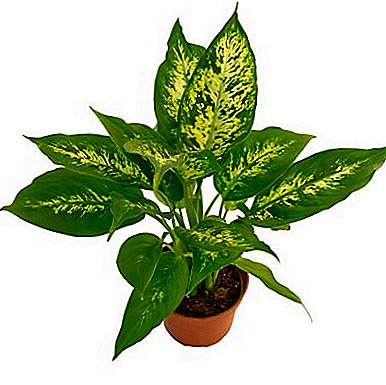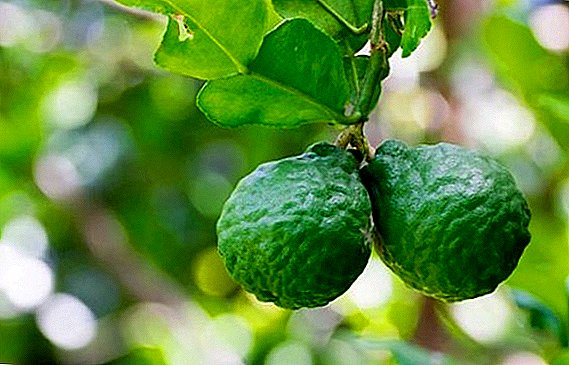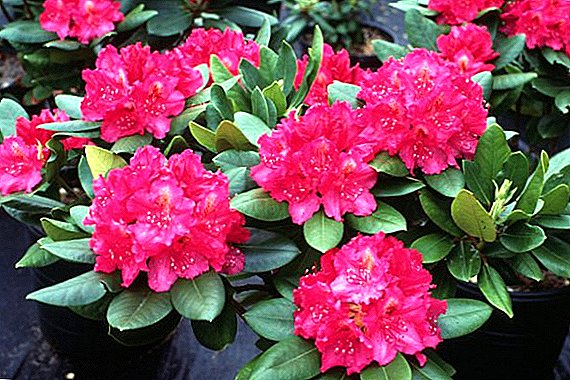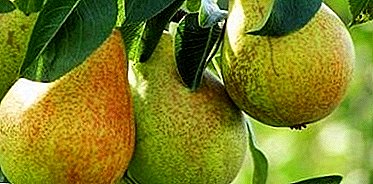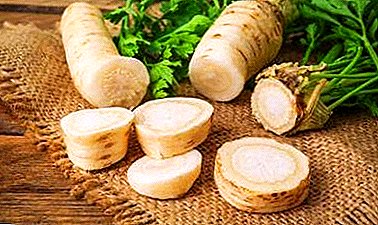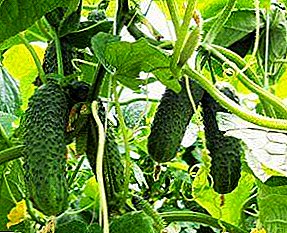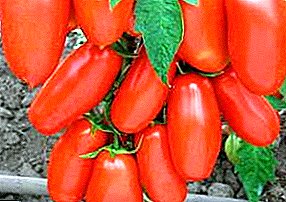 Spicy greens have become an indispensable ingredient in many cuisines of the world. One of the plants familiar in our latitudes is coriander or cilantro. The article discusses the best varieties of the plant, a detailed description and the details of its cultivation.
Spicy greens have become an indispensable ingredient in many cuisines of the world. One of the plants familiar in our latitudes is coriander or cilantro. The article discusses the best varieties of the plant, a detailed description and the details of its cultivation.
General description and characteristics of the plant
In the dual name of the plant, many are confused, but everything is quite simple - greens are called cilantro, and coriander seeds. As a spice or seasoning, they apply both.
Cilantro is an annual, belongs to the umbrella family. Spicy grass grows up to 70 cm, the stem is straight, branched closer to the top. Foliage is like parsley, though larger. Sheet plate dissected, three-lobed with long petioles.

The plant blooms in June miniature white or pale pink flowers. In July and August, seeds ripen on umbellate inflorescences - small, 2-3 mm in diameter, grains of brownish-yellow hue with numerous edges.
Did you know? In India, coriander is used as an aphrodisiac, in Oriental magic, it was one of the main ingredients of the love potion.
The plant is used not only in cooking, thanks to the essential oils and aroma, it is used as a perfume in perfumery and soap production, taking into account useful properties when using a spicy plant for cosmetic and medical purposes. Coriander is also a honey plant, its tart flavor attracts bees, the Karibe variety is notable for its particularly strong smell.

Most popular cilantro varieties
Vegetable or leaf coriander has many varieties that are grown both in open ground and under film cover.
We recommend reading about growing cilantro from seeds.
"Vanguard"
Terms of ripening varieties 45-47 days for greens. The bush is compact, dense, the socket is slightly raised. Plant height - up to 30 cm. Stems with dark green foliage straight, leaves have a glossy shine. One bush weighs about 20 g. The variety is resistant to bolting, recommended for open ground, frost-resistant. From one square meter collect up to 1.5 kg. 
"Borodino"
Greens ripen in 30-35 days after the appearance of the first shoots. Productivity is stable up to 2.3 kg / m². The stems are slightly curved, they form a dense rosette about 35 cm high. The size of the leaf plates is average, the surface is smooth, the edge is carved. The weight of the dark green outlet is up to 25 g. In cold regions it is better to grow in a greenhouse.
Learn also how to grow cilantro on a windowsill in an apartment in the winter.
The variety is often confused with the "Borodino" because of the similarity in the name, but the technical characteristics of the varieties are different.

"Kin-Dza-Dza"
Mid-season plant ripens in 50 days. Thick outlet reaches 60 cm in height. Greens bright, juicy color, with a strong aroma. Despite the mid-late ripening period, Kinza-dza is popular in vegetable growing. It is sown throughout the summer to collect spicy foliage all season. Productivity is high up to 2 kg / m².

"King of the Market"
Medium height, up to 55 cm, bush with a rounded rosette, densely leafy. Medium-sized leaf plates are strongly dissected, their edges with pronounced teeth. The variety is recommended for cultivation in the open field, frost-resistant, high-yielding - 2.9 kg / m². Mass of coriander under 35 
"Picnic"
Ripens within 35 days from the moment of shoots. Differs in large leaves, with strongly dissected plates. The leaf color is light green, the surface is glossy, the edge is notched. The height of the bush is about 40 cm, weight is up to 30 g. It is popular for growing on open beds, thanks to resistance to bolting and active growth of greenery. Crop yields up to 3.2 kg / m².

"Charm"
Frost-resistant coriander is sown in open ground as soon as the soil warms up to + 6 ° С. As it grows, a high, up to 60 cm socket with thick, bright foliage forms. The mass of one plant is 20 g, about 1.6 kg are collected from m². The ripening period is 50 days. 
"Chicot"
Frost-resistant "Chicago" ripens early, within 30 days. This fact allows you to plant it on the beds throughout the season. A raised, slightly sprawling rosette grows up to 60 cm. The foliage is bright green, strongly dissected, smooth. Plant weight about 25 g, yield 1.2 kg / m².

"Alekseevsky"
The grade is recommended for cultivation of seeds, there are two subspecies:
- "Alekseevsky 190" - bush up to 102 cm tall, with a thick, branched stem. Foliage begins to grow high from the base of the trunk, about 30 cm from the soil surface. The plates are rounded, the cut is weak, the surface is matte. The yield of seeds is 14.7 centners per hectare;
- "Alekseevsky 413" - the description is similar to the previous subspecies, the difference in the height of the bush: 413rd does not grow more than 90-100 cm. The subspecies has a lower seed yield - 12.4 c / ha.
Did you know? The famous alcoholic drink gin owes its unusual aroma and taste, including coriander oil.
Both species have moderate resistance to Ramulariosis. The period of ripening seeds to 104 days. 
"Ray"
A low bush in height to 50 cm, the weight of a plant on average is 30 g. The shape of the rosette is compact, the greens are thick, of medium size, of a juicy green color. Productivity is stable up to 1.7 kg / m². Plant a variety of greens during the season.

Chemical composition and calorie cilantro
Green coriander has a strong aroma, which indicates the presence in its composition of essential oils. In addition, cellulose, routines and phytoncides are present in the land part of the plant.
Foliage is rich in vitamins and minerals:
| Vitamins: | Minerals: |
|
|
Calories - 23 kcal / 100 g of the product.
Useful properties and possible contraindications
Due to its rich composition, greens and coriander seeds have many beneficial effects for the body.
With regular consumption, seasoning has a beneficial effect on the organs of the gastrointestinal tract and digestion processes.
- Stimulates intestinal motility.
- Regulates the secretion of gastric juice.
- Removes toxins, cleans the stomach from undigested food debris.
- It soothes the mucous membrane of the digestive organs, relieving inflammation.
- Helps to digest fatty, starchy foods, with a predominance of coarse dietary fiber.
 Cilantro has a soothing effect.It helps to defeat insomnia, improve body tone. The use of the product for therapeutic purposes improves performance and improves memory. Active bactericides The product cleans the oral cavity from pathogenic bacteria. Chewing grains or greens helps get rid of bleeding gums and an unpleasant smell.
Cilantro has a soothing effect.It helps to defeat insomnia, improve body tone. The use of the product for therapeutic purposes improves performance and improves memory. Active bactericides The product cleans the oral cavity from pathogenic bacteria. Chewing grains or greens helps get rid of bleeding gums and an unpleasant smell.
We advise you to read about the beneficial properties of cilantro for women.
Phytoncides and vitamins help to dilute phlegm with respiratory diseases. Decoction gargle with sore throat and pharyngitis. The plant has a beneficial effect on the work of the heart muscle, helps to normalize blood pressure. Coriander clears the blood vessels from the accumulation of cholesterol plaques, strengthens the walls of capillaries and blood vessels. Regular consumption of spices improves the ability of blood clotting.
Essential oil is used in official medicine as an ingredient of a drug for glaucoma. In traditional medicine decoction treats decoction. In cosmetology, the bleaching, purifying and nourishing properties of the plant are used. 
Despite the enormous benefits, not all benefit from eating cilantro. There are conditions and diseases in which it will harm or aggravate the health problem.
Use of the product is contraindicated in such cases:
- thrombophlebitis;
- a stroke or heart attack;
- pregnancy;
- exacerbation of gastrointestinal ulcers, gastritis;
- ischemia;
- hypertension;
- diabetes.
Important! You can eat no more than 35 g of greens per day without any damage to your health.
Spice abuse leads to side effects:
- failure of the menstrual cycle (in women);
- decreased sex drive (for men);
- insomnia;
- problems with memory function;
- hormonal disorders.
Basic rules for growing cilantro
First of all, you need to choose good predecessors for the culture. These are:
- early grain crops;
- legumes;
- potatoes.
Land for planting should be flat or elevated, without the accumulation of moisture. Groundwater is located 1.5-2 meters from the soil surface. The place is preferably open to the sun, in the shade coriander develops poorly. The soil is neutral -7pH, loose and nutritious.

Before planting the site is cleaned, dug up and make humus and wood ash, then moisten. Conduct this training in the fall.
In spring, depending on the region, sowing is carried out at the beginning or at the end of April.. The main condition is the absence of the risk of return frost. Sowing is carried out in wells of 2-3 grains, the distance between them is up to 15 cm. In consequence, if necessary, the crops are thinned out, removing weak shoots.
In the future, you need to follow the watering. The frequency of soil moistening depends on the measure of its drying and the amount of precipitation.. If the soil is dry to a depth of 20 cm watering is necessary, but note that an excess of moisture will lead to decay of the root and the whole plant. Together with irrigation, it is necessary to loosen the soil in order to saturate it with oxygen. Weeds are removed as they appear.
Important! It is not recommended to make chemical fertilizers, feed the plant in the future. First, it is enough for it to bring in power during planting, and secondly, the foliage tends to accumulate elements obtained from the soil.
When following the rules of crop rotation and agrotechnics, there are no difficulties in growing crops. In case of errors or adverse external factors, possible damage by disease (bacterial burn, Ramilariosis) or insects (bug, moth, leaf beetle). It is not advisable to use chemicals to combat problems, because foliage can absorb toxins. As an alternative, traditional methods are used as a treatment: decoctions and infusions of various plants.
Spicy herbs and seeds not only enrich culinary products with aroma and taste, but can also have a beneficial effect on health. Growing coriander is possible both in the household plot and at home.


